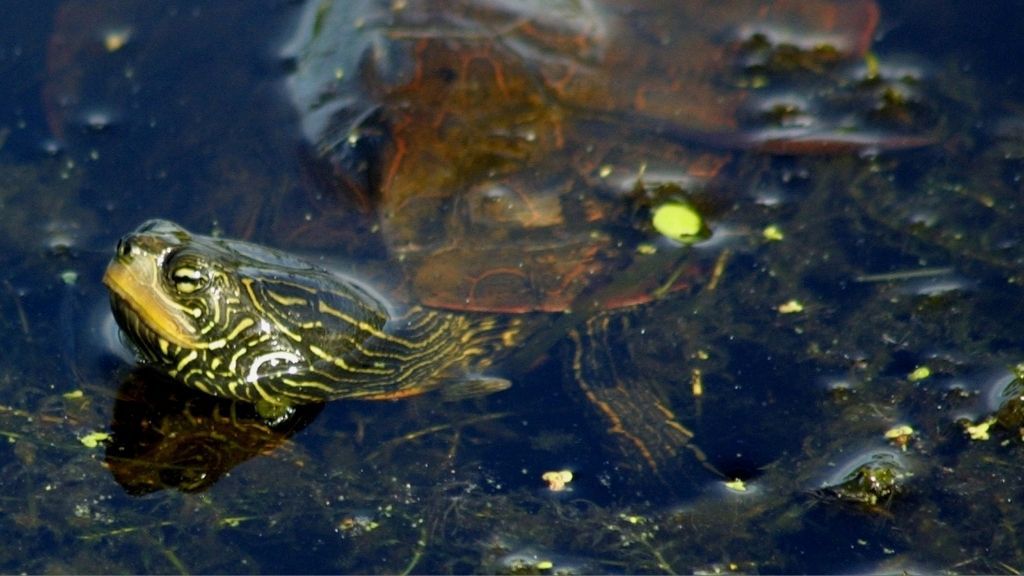Tags:
The Ultimate Guide to Determining a Turtle’s Gender [For Beginners]
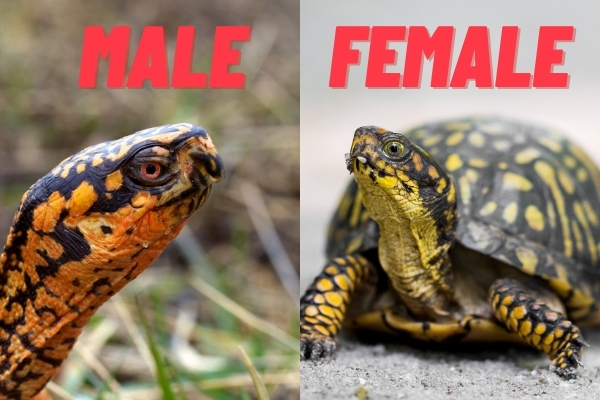

fact checked & review by
Dr. Partho Kumar Shaha
Veterinarian (DVM)
The information is current and up-to-date in accordance with the latest veterinarian research.
If you are a pet turtle owner, then I bet there are many times you’ve wondered if your turtle is a male or female. In this article, I’ll try to give clarification to the question how can you tell if a turtle is male or female.
Identifying the gender of a turtle is not a simple task to do. Unlike other mammals, turtles do not have any distinct sign that declares its gender such as external genitalia. It makes identifying the sex of a turtle much more challenging, but not impossible. There are some physical differences between a male and a female turtle. These differences are subtle and may require close looking to identify.
The easiest way is to examine the turtle’s tail and underside. Males have longer, thicker tails that taper to a point. Their undersides are concave. Females have shorter, stubbier tails, with undersides that are more rounded and flatter. Alternatively, gently press above the tail on the underside, near the cloaca. In response, males often extend their reddish-pink penises.
It is better if you have both a male and female turtle so that you can compare both and identify the gender easily. If you have only one turtle, then try to match as many physical aspects as possible to accurately determine the gender.
key takeaways
- Examine the turtle’s tail – males have longer thicker tails that taper to a point, females have shorter stubbier tails.
- Look at the turtle’s underside – males have a concave underside, females are more rounded and flatter.
- Gently press above the tail near the cloaca region- males may extend their reddish pink penises when pressed.
- Size can indicate turtle’s gender – males tend to be larger than females for many turtle species.
- Listen for turtle’s mating calls – some species like red-eared sliders make distinct noises that indicate gender.
- Wait for turtle’s mating season – during breeding season, gender differences will be more obvious as males display mating behaviors.
- Consult a vet – a veterinarian can examine the turtle closely and definitively determine its sex.
Turtle Gender Identification Chart
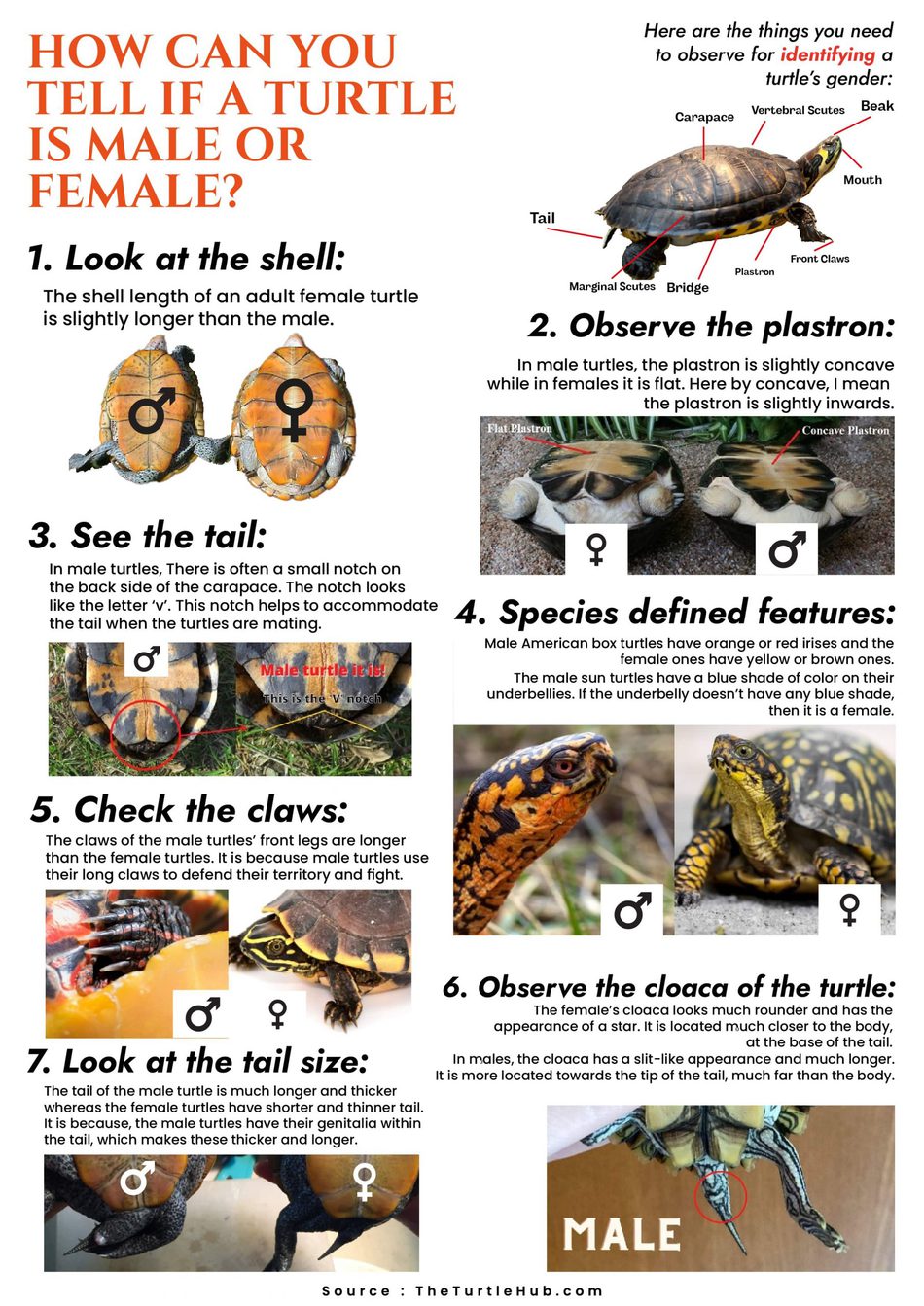
For a printable version of this amazing visual chart, click here!
How To Identify A Turtle’s Gender?
Here are the things you need to observe for identifying a turtle’s gender:
| Male Turtles | Female Turtles |
|---|---|
| Longer, thicker tails that are often longer than the turtle’s shell (source) | Shorter tails that do not extend past the shell |
| Concave plastron (underside of shell) that curves inward (source) | Flat plastron that does not curve inward |
| Longer, thicker claws for gripping the female during mating | Shorter claws |
| Smaller overall size than females | Larger overall size to accommodate egg development |

1. Look at the shell:
Male and females have different shells, also known as the carapace. The shell length of an adult female turtle is slightly longer than the male.
- This is not a fully reliable way to determine the sex. You need to look for additional things. Also, this method is limited by the age of the turtle. you cannot apply it to baby turtles as they have much more growing to do. The only adult matured turtles are applicable for this method.
2. Observe the plastron:
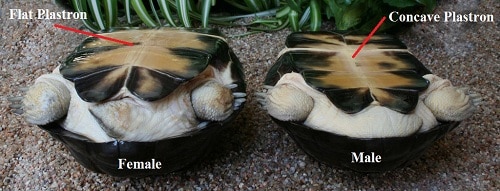
If you don’t know what plastron is, it is the underside of the shell, which covers the belly of the turtle. for observing the plastron, you need to lift up your turtle carefully. Turtles don’t like to be handled generally. So, pick your turtle by the end of the tail so that it can’t bite you. Now, calmly turn over the turtle to see the plastron.
In male turtles, the plastron is slightly concave while in females it is flat. Here by concave, I mean the plastron is slightly inwards.
Here is some interesting fact about the plastron: the concave plastron of the male turtle helps it to get on the shell of the female turtle for mating. It prevents the male turtle from rolling off. On the other hand, the flat plastron helps the female turtle more space for growing her eggs.
Most sea turtle species determine sex based on the temperature of the nest during incubation. Warmer temperatures tend to produce more females, while cooler temperatures produce more males. According to a study on Australia’s Great Barrier Reef, 99% of immature green sea turtles were born female.
3. It’s time to see the tail:
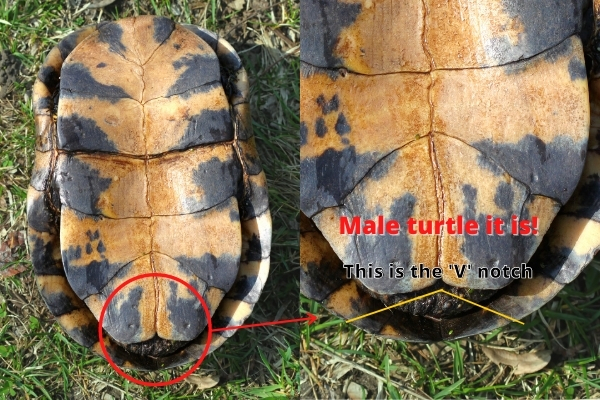
This is a very subtle difference and hard to find. In male turtles, there is often a small notch on the back side of the carapace. The notch looks like the letter ‘v’. This notch helps to accommodate the tail when the turtles are mating.
Need To Talk With A Turtle Vet Right Now?
4. Species defined features:

There are some species of turtles that have gender-specific bodily features which is helpful to identify their sex.
Suppose, more than 80% of the time, male American box turtles have orange or red irises and the female ones have yellow or brown ones.
The dome of the females is more high, rounded whereas the male ones are short and have an oval appearance.
It is very easy to identify the sex of sun turtles. The male sun turtles have a blue shade of color on their underbellies. If the underbelly doesn’t have any blue shade, then it is a female.
5. Check the claws:
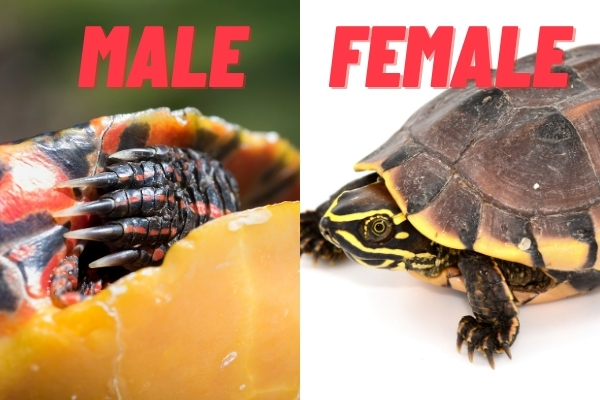
The claws of the male turtles’ front legs are longer than the female turtles.
It is because male turtles use their long claws to defend their territory and fight. Also, these claws come into play when the male turtle is mating with the female.
- This identification method is super helpful if you have two turtles of different genders to compare.
- Red-eared slider turtles show this difference more than any other species.
Rising global temperatures due to climate change have skewed sex ratios in some sea turtle populations. For example, a recent study of 75 sea turtle rookeries worldwide found the ratio of females to males was approximately 3 to 1 (source).
6. Observe the cloaca of the turtle:
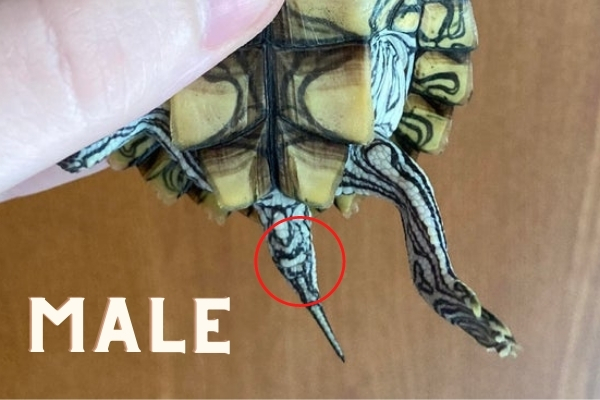
The cloaca is the vent located at the underside of the tail of the turtle. Both male and female turtles have a cloaca. The location of the cloaca differs according to the gender of the turtle.
Identifying a turtle’s gender can be challenging, especially for beginners, as Bradfield Johnson, a seasoned reptile hobbyist, explains.
While observing the cloaca is a common method, Johnson notes, “Right out of the egg and without knowing the incubation temps, it’s extremely difficult to determine the sex of a turtle outside of a blood test.”
Nevertheless, the cloaca, located on the underside of the turtle’s tail, varies between genders.
Females exhibit a rounder, star-like cloaca near the base of the tail, almost disappearing into the shell. In contrast, males have a slit-like, longer cloaca positioned further down the tail, discernible in the last third region.
This distinction becomes more apparent as aquatic species such as sliders, painted turtles, and cooters develop their sexual characteristics, with males growing noticeably longer claws on their front feet.
- The female’s cloaca looks much rounder and has the appearance of a star. It is located much closer to the body, at the base of the tail. The cloaca seems almost disappearing inside the shell.
- In males, the cloaca has a slit-like appearance and much longer. It is more located towards the tip of the tail, much far than the body. You can find the male cloaca in the last third region of the tail.
7. Look at the tail size:
The tail of the male turtle is much longer and thicker whereas the female turtles have shorter and thinner tail.
It is because, the male turtles have their genitalia within the tail, which makes these thicker and longer.
Don’t rely on this technique alone to identify the sex of the turtle. it is not a foolproof way as the sizes of tails often overlap between a male and a female turtle.
8. Try to apply as many techniques as you can:
None of the method mentioned above is 100% reliable on their own. To get the perfect result, you need to combine as much method as you can and test them all. Try as many suggestions as you can that are mentioned above so that you can get a much accurate result.
As I have said earlier, some methods are less reliable than others. Only a combination of them will work best for identifying the sex of a turtle.
If you find that all the suggestions are giving result in one direction, then be sure that you are getting the accurate result. However, if the suggestions are giving a mixed result, then chances are you need to go to the vet or a professional to correctly identify the sex of the turtle.
Always keep in mind that it is extremely difficult and nearly impossible to identify the sex of a baby turtle. so, if your turtle is not adult, you need to wait and try again when it is matured.
The amount of time that it takes for a turtle to be adult varies from species to species. So, research on your pet turtle species and determine how long it will take for it to be adult. You need to wait that amount of time for correctly identifying the gender.
At some beaches in Australia, over 99% of new hatchlings are now female due to warming temperatures (source).
Can you Rely on Eye Color?
Some people say that the male turtles’ eye has much brighter red shade than the female turtles. However, I find this very unreliable as there are many female turtle species with bright red eyes. I’ll never recommend depending on the eye color to sex your turtle.
breeding season behavior: male vs female turtles
Here is a table listing some differences in behaviors exhibited by male and female turtles during breeding season:
| Male Turtles | Female Turtles |
|---|---|
| Roam in search of receptive females | Remain stationary and receptive to males |
| May bite and nip at females as a courtship behavior | May resist initial male advances |
| Make loud clicking, popping or wheezing noises | Make softer sounds or remain quiet |
| Initiate mating attempts including mounting the female | Allow or resist mating depending on readiness |
| No nesting or egg-laying behavior | Nest, lay eggs, and guard nest site |
How to Tell if a Baby Turtle is Male or Female?
It is very difficult and nearly impossible to identify the sex of a baby turtle. Most of the gender identifying tricks of turtles are applicable to only adult turtles. In case of baby turtles, these techniques fail to work.
The identification will be easier if you have two different gender baby turtles for comparing.
Here are some general ways to tell if a baby turtle is male or female:
- The front claws will be longer in male baby turtles than the females.
- Male baby turtles will have longer and thicker tails as they carry their genitalia in the tail. On the other hand, female turtles’ tails are shorter and thinner.
- The other thing you can look for is the location of the cloaca. The cloaca is the vent or opening underneath the tail. In female turtles, the cloaca is located more towards the body and at the base of the tail. In males, it is located more towards the tip of the tail.
How to Tell the Gender of a Red-Eared Slider Turtle?
Red-eared sliders are one of the most common species of pet turtles across the United States. When it comes to identifying the gender, red-eared sliders are the easiest one to do so. They have quite distinct physical differences between a male and female.
It helps if you have two opposite gender red-eared sliders to compare the physical differences. Here are some ways to tell the gender of a red-eared slider turtle:
- Size is a good way to differentiate between male and female red eared sliders. However, this technique is only limited to adult red-eared sliders. So, if your red-eared slider is not matured, then you can’t apply this technique. Female red-eared sliders tend to be slightly longer than the male ones when they are adult.
- The length of a female red eared slider typically ranges from 10 to 13 inches long whereas the male ones are 8 to 10 inches long. This is not a 100% accurate method to determine the sex of a turtle as there are many other factors which come into play, such as the age.
- Observing the claws are one of the easiest and most accurate ways to identify the gender of a red-eared slider turtle. the front claws of the male red-eared sliders tend to be longer than the female ones. The males use these long claws to fight and protect their territory. They also use these claws when they are mating.
- Red-eared sliders of both sex generally have a green body with vibrant yellow strikes all over the body. However, as the red-eared sliders mature, the start to have a darker, blackish color over their body. This dark color is more prominent in males than females. So, if you’ve come across a darker red-eared slider, then chances are it is a boy.
- As the males carry their genitalia in their tales, the males have a bit longer and thicker tails than the females.
Difference between Male and Female Painted Turtles:
The gender identification techniques for painted turtles are almost identical to the techniques for red-eared sliders. Here are the ways to differentiate between a male and female painted turtle:
- Like the red-eared sliders, adult female painted turtles tend to be larger than the male ones. The plastron of female painted turtles tends to be 4 to 5 inches long. On the contrary, male painted turtles only have a 3 to 4 inches long plastron.
- The body development speed is also different between a male and female painted turtle. it takes about 6 to 10 years for a female painted turtle to get matured. On the other hand, males only need 3 to 5 years for getting sexually matured.
- Male painted turtles have longer and thicker tails than the females.
- Like the sliders, male painted turtles have longer front claws than the females. These long claws are necessary for fighting, protection, and mating.
- The appearance of the plastron is also different in males and females. The male turtle’s plastron has a concave appearance whereas the female plastrons are flat. This special type of appearance is necessary for mating.
All the techniques mentioned above are applicable to an adult painted turtle. however, if you have a baby painted turtle, it becomes extremely confusing to identify the gender. Here are a couple of ways to guess the gender of a baby painted turtle:
- The temperature of the incubator or the nest can determine the gender of a baby painted turtle when they are still in the eggs. Cooler temperature tends to produce a higher ratio of males, on the contrary, warmer temperature produces more females.
A recent study showed that, in captive breeding, if you set the incubator temperature around 87 degrees Fahrenheit, the hatchlings will be mostly female. On the other hand, if the temperature is 77 degrees Fahrenheit, most of the hatchlings will be male.
- Male baby painted turtles have longer front claws and lengthier and thicker tails. The cloaca is also located away from the body, on the tip of the tail in male baby painted turtles.
Difference between Male and Female Box Turtles:
Box turtles carry their sex organs inside their shells.
So, it is pretty confusing to identify the sex of a box turtle. we need to depend on the physical characteristics difference between a male and female box turtle to correctly identify their gender. Here are some of the physical characteristics differences between male and female box turtles:
- Usually, male box turtles are more colorful than the females. They have vibrant colorful legs and heads. Male box turtles have orange, red, white as well as black markings on their faces. They also have a reddish eye whereas the female ones have deep brown eyes.
- Male box turtles have a slightly concave plastron which helps them during mating. The female ones have a flat plastron.
- The males have wider and highly marked back toes. They are like small talons. On the other hand, the females’ back toes are straighter and thinner.
- The male box turtles’ tails are wider at the base where it joins the body. The females have shorter and thinner tail. The location of the anus also helps to determine the sex of a box turtle. in males, it is situated towards the tip of the tail, much farther than the body. The females have their anus close to the body, towards the base.
How to Tell if a Yellow Belly Turtle is Male or Female?
- The easiest way is to observe the tail. Males have longer and thicker tails than the females as they carry their genitalia in it.
- The position of the anus also declares the sex of the turtle. In females, the anus is closely located towards the body, at the base of the tail. In males, it is more towards the tip of the tail, further away from the body.
- Male yellow bellied turtles have longer front claws than the females. These longer claws are necessary for protection and mating.
- Female yellow bellied turtles tend to be longer in size than the males when they have reached maturity.
How to Identify Musk Turtle Gender?
- The males have a concave plastron whereas the females have a flatter plastron.
- The males have longer and thicker tails than the females.
How to Identify Mississippi Map Turtle Gender?
- Adult female Mississippi map turtles are longer than the males. The males grow up to 3.5 to 5 inches long whereas the females can grow up to 6 to 10 inches long.
- Males have longer and thicker tails. The females’ tails will be much shorter, thinner and smaller.
- The males have longer claws on their front feet than the females. The claws are sharper in the male too.
- The males have their cloaca towards the tip of the tail, whereas the females have them more towards the body, at the base of the tail.
- The females have a flatter plastron whereas the males’ plastrons are more concave looking.
How to Identify Mud Turtle Gender?
- The males’ tails are about three times longer than the female mud turtles. The males have such a long tail that they often tuck it sideways under their shell. On the contrary, the females have a very short tail which doesn’t need any tucking.
So, this is my detailed answer on how can you tell if a turtle is male or female. I hope this guide will help you to successfully identify the gender of your turtle. let me know if you have any questions in the comment box below.
African Sideneck Turtle Male Or Female: Gender Identification Tricks
Once your African sideneck turtle grows to adulthood (roughly 7 – 12 inches), you can tell its gender by observation.
Of course, gender determination is not possible with a baby or juvenile turtles.
I have already mentioned the factors you need to go through to identify the gender of any aquatic or semi-aquatic turtles. The rules are no different for African sideneck turtles. Here are the features that differentiate the African sideneck males from the females,
1. Plastron: The African sideneck female turtles have a flat plastron, while the males have a concave lower shell.
2. Private Part & Tail: Apparently, the male African sideneck turtles have thicker and longer tails. Besides, their vent is closer to the end of the tail. However, with females, the tails are shorter and slimmer. Their cloaca is positioned at the end of the tail and features a notch.
3. Overall Carapace Growth: Usually, the female sideneck turtles grow larger than the males. For example, the average carapace size for females is 7 – 12 inches. On the contrary, the male African sideneck turtles develop an upper shell of roughly 10 inches.
4. Claws: Turtles need claws for digging and mating purposes. In the African sideneck turtles, the males have slightly longer claws than the females.
Some experts claim that the male and female African sideneck turtles also show differences in the scute designs. However, this statement is not verified yet.
Where Are Turtle’s Private Parts?
If you are wondering whether turtles have a penis or vagina, the answer is yes. The anatomy of turtles is surely different from ours, but apparently, the mating process is the same.
Private parts of the species are located inside their tails. For example, penises are hooked at the end of the tail, just beside the sperm duct. It means the organs stay hidden and protected with the tails.
The male turtle penises are surprisingly long. For example, it can be up to 10 inches for red eared sliders and 12 inches for green sea turtles.
On another note, male turtles have testicles or balls too. But the testicles stay concealed even during the mating.
During the intercourse, the male turtle first smells the female to locate her cloaca. Next, he uses his tail hook to bring the cloaca of the female closer to him. Finally, he enters his penis inside the female’s cloaca, and they get involved in mating.
Does A Turtle Have A Tail?
Both the turtles and tortoises have tails, which are quite visible. Just like any other body features, tails play a significant role in functioning the day-to-day life of the turtles. Such as,
- Turtles use their tails as anchors if they need to climb a rock or fence.
- The tail brings balance when walking on a wet or slippery path.
- The private parts of turtles are located at the rear end of the tails. In another sense, the reproductive organs stay protected with the tails.
- During the breeding session, tails play a huge part. The male turtle uses the tail hook to bring his cloaca closer to his partners. After that, he enters his penis into the female’s cloaca for mating.
Are Female Turtles Bigger Than Males?
Turtles definitely exhibit sex dimorphism with carapace length. In some species, the male turtles are bigger than the females, while the scene is the opposite for other species.
For example, in the African sideneck turtles, the females are larger than the males. The case is the same with red eared sliders, painted turtles, map turtles, etc. On the contrary, box turtle males always grow bigger than females.
However, some species, like snapping turtles, show no such dimorphism. It means males and females of these species are almost the same size.
Decision Table To Help You Determine Your Turtle’s Gender
Here is a decision table outlining some key identification questions owners could ask about their turtle with possible “Male” or “Female” answers:
| Question | Male | Female |
|---|---|---|
| Is the tail longer than the shell? | Yes | No |
| Does the plastron (underside of shell) curve inward? | Yes | No |
| Are the claws noticeably long and thick? | Yes | No |
| During breeding season, does the turtle exhibit roaming or biting behaviors? | Potentially yes | No |
| Is the turtle notably larger in size than other turtles of the same age? | No | Potentially yes |
| When gently pressing above the tail, can two distinctive openings be felt? | Yes, one on each side | Potentially yes, one central opening |

About Author
Muntaseer Rahman started keeping pet turtles back in 2013. He also owns the largest Turtle & Tortoise Facebook community in Bangladesh. These days he is mostly active on Facebook.
Disclaimer
This site is owned and operated by Muntaseer Rahman. TheTurtleHub.com is a participant in the Amazon Services LLC Associates Program, an affiliate advertising program designed to provide a means for sites to earn advertising fees by advertising and linking to Amazon.com. This site also participates in other affiliate programs and is compensated for referring traffic and business to these companies.



